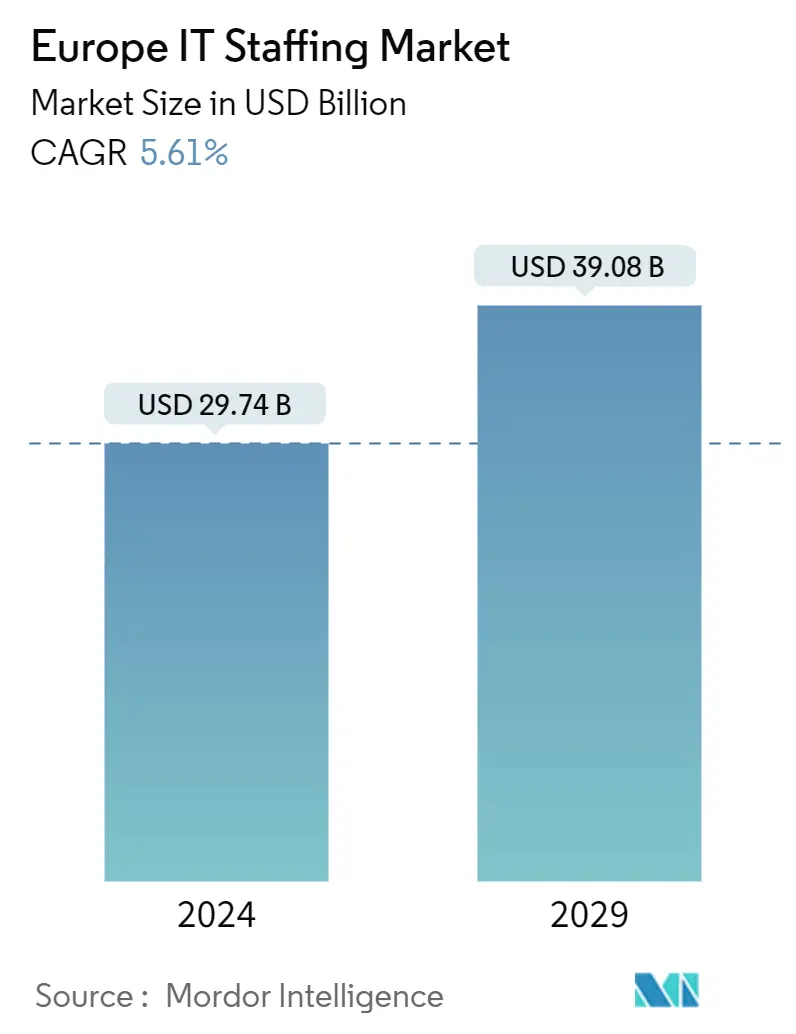Market Size of Europe IT Staffing Industry

| Study Period | 2019-2029 |
| Base Year For Estimation | 2023 |
| Market Size (2024) | USD 29.74 Billion |
| Market Size (2029) | USD 39.08 Billion |
| CAGR (2024 - 2029) | 5.61 % |
| Market Concentration | Low |
Major Players
*Disclaimer: Major Players sorted in no particular order |
Europe IT Staffing Market Analysis
The Europe IT Staffing Market size is estimated at USD 29.74 billion in 2024, and is expected to reach USD 39.08 billion by 2029, growing at a CAGR of 5.61% during the forecast period (2024-2029).
The trend of an expanding contingent workforce is a major driver of the region's IT staffing market's expansion. Large IT companies prioritize outsourcing specific business functions for their organization's scalability, flexibility and decreased risk.
- Further digital developments and technologies, such as data analytics, robotics, the internet of things, blockchain, AI, and machine learning, are compelling businesses to adopt fresh and creative project execution strategies. These tasks usually need skills that are hard to obtain in a single specialist. Hence, recruiting workers with the most talent at the lowest cost possible encourages IT staffing companies to run effectively.
- There is currently a greater need for IT security specialists due to changes in IT staffing. This includes the staff members responsible for security operations, information security officers, analysts, support engineers, cyber defense specialists, threat vulnerability engineers, and network security technicians.
- Under a proposed concept, gig workers in the EU would not be regarded as self-employed, but rather would be given the status and privileges of employees. A proposal from the European Commission would make substantial progress in creating digital platforms to manage their gig employees. Indirectly, this will benefit Europe's IT staffing industry.
- The region's tendency toward staffing automation enables staffing and recruiting firms to set up an automated, repeatable operating system in their hiring procedures. These methods are computerized and meant to improve the hiring experiences of the candidates and clients. Because HR automation will reduce their market share in the future, the automation of recruiting in the European region presents a significant challenge for IT staffing providers.
- The transition from work done in offices and other physical locations to work done remotely was one of the most major developments brought about by the COVID-19 pandemic in the corporate sector. When the geographical constraints were removed, European IT staffing companies could service new clients in new regions and draw candidates from recent locales and possibly new countries. On the other hand, as geographical boundaries disappeared, new competitors appeared, endangering a staffing firm's current clientele.
- European IT staffing companies have an additional opportunity to serve as consultants and business partners, advising clients on their talent options and strategies due to the growing complexity.
Europe IT Staffing Industry Segmentation
The major goal of the IT staffing process is to locate qualified applicants to fill various job roles inside the IT firm. It involves finding applicants, evaluation, selection, recruitment, and appraisal, which are parts of the systematic implementation process of the human resources plan.
The European IT Staffing market can be classified by end-user industry (telecom, BFSI, healthcare, manufacturing, retail), by country (United Kingdom, Germany, France, Spain, Italy, and the Rest of Europe). The report offers market forecasts and size in value (USD) for all the above segments.
| By End-user Industry | |
| Telecom | |
| BFSI | |
| Healthcare | |
| Manufacturing | |
| Retail |
| By Country | |
| United Kingdom | |
| Germany | |
| France | |
| Spain | |
| Italy | |
| Rest of Europe |
Europe IT Staffing Market Size Summary
The European IT staffing market is experiencing significant growth, driven by the increasing demand for specialized skills in emerging technologies such as AI, IoT, and blockchain. The shift towards a contingent workforce, where companies outsource specific IT functions, is a key factor in this expansion. This trend is further fueled by the rapid digitalization across various industries, necessitating robust IT support for internet-based applications. The COVID-19 pandemic has also played a pivotal role in transforming the market, as the transition to remote work has allowed staffing companies to tap into new geographical markets, although it has also introduced new competitors. The automation of staffing processes and the rise of on-demand staffing platforms are reshaping the recruitment landscape, offering both opportunities and challenges for IT staffing providers in the region.
The market is characterized by a high degree of fragmentation, with numerous players vying for a share of the growing demand for IT talent. Companies are increasingly focusing on specialized recruitment strategies to meet the needs of clients seeking expertise in niche areas. The European IT staffing industry is also benefiting from substantial investments in technological startups and initiatives aimed at fostering innovation, such as the establishment of AI innovation labs and the development of metaverse work environments. Despite challenges such as rising costs and geopolitical tensions, the market is poised for continued growth, supported by the ongoing digital transformation and the increasing reliance on technology across sectors.
Europe IT Staffing Market Size - Table of Contents
-
1. MARKET INSIGHTS
-
1.1 Market Overview
-
1.2 Value Chain / Supply Chain Analysis
-
1.3 Industry Attractiveness - Porter's Five Forces Analysis
-
1.3.1 Bargaining Power of Suppliers
-
1.3.2 Bargaining Power of Buyers/Consumers
-
1.3.3 Threat of New Entrants
-
1.3.4 Threat of Substitute Products
-
1.3.5 Intensity of Competitive Rivalry
-
-
1.4 COVID-19 Impact on the Market
-
-
2. MARKET SEGMENTATION
-
2.1 By End-user Industry
-
2.1.1 Telecom
-
2.1.2 BFSI
-
2.1.3 Healthcare
-
2.1.4 Manufacturing
-
2.1.5 Retail
-
-
2.2 By Country
-
2.2.1 United Kingdom
-
2.2.2 Germany
-
2.2.3 France
-
2.2.4 Spain
-
2.2.5 Italy
-
2.2.6 Rest of Europe
-
-
Europe IT Staffing Market Size FAQs
How big is the Europe IT Staffing Market?
The Europe IT Staffing Market size is expected to reach USD 29.74 billion in 2024 and grow at a CAGR of 5.61% to reach USD 39.08 billion by 2029.
What is the current Europe IT Staffing Market size?
In 2024, the Europe IT Staffing Market size is expected to reach USD 29.74 billion.

